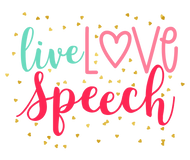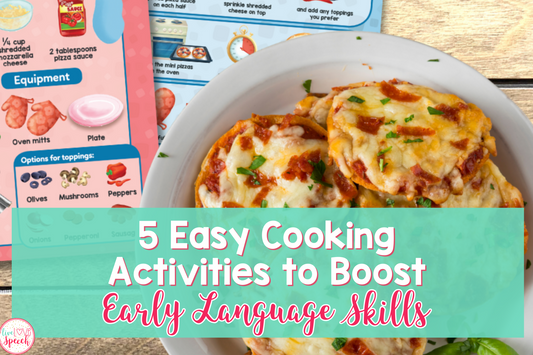
The holidays are the perfect time to add in some fun while teaching vocabulary, but how do you move beyond the usual activities?? By incorporating hands-on, interactive projects, you can engage kids in ways that feel fresh, excitttting, and outside the box.
One enjoyable way to approach this is by using holiday-themed recipes to bring seasonal vocabulary to life. Cooking activities not only foster language skills but also keep kids interested and excited during this festive time.
Why Holiday Recipes Work for Language Skills
Recipes are a great way to combine multisensory learning with vocabulary practice. Kids get to see, touch, and taste as they explore words related to colors, textures, shapes, and actions.
This hands-on approach strengthens their understanding and helps them connect language to real-world experiences!
Holiday Recipes with Target Vocabulary
1. Popcorn Snowballs

Before You Begin:
Describe what a snowball is and how it relates to winter. Show a picture or use a toy snowball to provide context.
Target Vocabulary:
snow, cold, round, soft, sticky, white
💡
Activity Tip:While making these popcorn snowballs, explore how they
look and
feel. Ask kids to describe the
texture (e.g.,
soft,
sticky) and
color (e.g.,
white). Practice verbs such as "
mix" for combining the ingredients, "
squeeze" for shaping the snowballs, and "
shape" as they form them into rounds. This
multi-sensory approach deepens understanding of the vocabulary in a
fun and
memorable way.
Grab your resource here!
Extended Activity:
Add to the winter theme by reading books like The Snowy Day by Ezra Jack Keats. The story is perfect for discussing snow-related vocabulary and connects beautifully to the snowball activity. This story is also included in my Winter-Themed Adapted Book Pieces!
Which includes two other winter-themed books! After making the popcorn snowballs, have a sensory bin with cotton balls or fake snow for kids to explore concepts like soft and round.
2. Holly Jolly Snack Mix

Before You Begin:
Ask kids what the word “jolly” means and connect it to holiday cheer. Discuss how red and green are often seen during Christmas.
Target Vocabulary:
jolly, mix, sweet, crunchy, red, green
💡 Activity Tip:
Get kids involved by naming each ingredient—pretzels, marshmallows, and M&Ms. Use descriptive words for colors, such as red and green, and discuss textures: “Are the marshmallows soft or crunchy?”
Encourage them to use
action words like "
pour" and "
stir" as they help prepare the snack. Comparing and contrasting
ingredients is another way to
expand vocabulary.
Grab your resource here!
Extended Activity:
Keep the holiday cheer going by singing songs like Jingle Bells or We Wish You a Merry Christmas. Use the mix as a prop for counting activities or color-sorting games. This helps expand vocabulary while also sneaking in math and sorting skills.
3. Hot Cocoa

Before You Begin:
Show a mug of hot cocoa and ask kids how it feels to drink something warm on a cold day.
Brainstorm words they associate with chocolate or cozy winter nights.
Target Vocabulary:
warm, chocolate, stir, marshmallow, mug, sip
💡 Activity Tip:
Focus on sequencing as you make cocoa together: "First, pour the milk; next, stir in the chocolate; finally, sip it slowly."
Use WH-questions like “What do we put in the
mug first?” or “How does the cocoa feel? W
arm or
cold?” This activity supports both
vocabulary and
comprehension skills.
Grab your resource here!
Extended Activity:
Pair this cozy recipe with Froggy Gets Dressed by Jonathan London. The book introduces winter clothing vocabulary and can lead to discussions about staying warm. This book is also included in another one of my Adapted Book Pieces!
You can find it here in my Weather Themed Adapted Book Pieces! You could also play a sequencing game where kids arrange picture cards showing the steps of making hot cocoa.
4. Marshmallow Snowman

Before You Begin:
Ask kids to describe what they know about snowmen. Show a picture of a real snowman and compare it to the marshmallow version you’re about to make.
Target Vocabulary:
snowman, marshmallow, stick, scarf, carrot, button
💡 Activity Tip:
Guide kids through each step of building their marshmallow snowman, using words like "stack" to place marshmallows on top of each other, "push" for inserting the stick, and "decorate" for adding details like the scarf and buttons.
Positional words like "
on top" or "
beside" can enhance spatial awareness as you talk through the process.
Grab your resource here!
Extended Activity:
For some snowman fun, read Snowmen at Night by Caralyn Buehner. Talk about what snowmen might do when no one is watching, introducing imaginative play. Use the marshmallow snowman craft to create stories or practice positional words like beside, on top, or under.
5. Reindeer Cookies

Before You Begin:
Talk about reindeer and how they are part of holiday traditions.
Show a picture of a reindeer and discuss its features (antlers, eyes, nose).
Target Vocabulary:
reindeer, antlers, eyes, nose, brown, cookie
💡 Activity Tip:
Start by naming each decoration, like the pretzels (antlers), candy eyes, and red candy (nose). As kids assemble their cookies, discuss the parts of a reindeer and use action words like "place" and "attach."
You can also encourage
imaginative play by pretending the cookies are actual
reindeer and describing their features.
Grab your resource here!
Extended Activity:
After making the cookies, read
Rudolph the Red-Nosed Reindeer to bring the reindeer theme full circle. Kids can decorate a paper reindeer craft or play a game matching reindeer parts to reinforce the vocabulary they practiced while making the cookies. Another idea would be reading How to Catch a Reindeer! Incorporate Boom Cards for this story!
You can find all the details here!
Pairing Recipes with Books and Activities

By pairing these recipes with books, songs, and activities, you can turn holiday cooking into a comprehensive learning experience that’s as fun as it is educational. Kids will enjoy the creative process while building their vocabulary in a natural and interactive way!
Ready to Get Cooking?
For more ideas and tips, be sure to check out my other blog posts and resources. Happy cooking and learning!
Don’t forget to pin this post for easy access to these fun and seasonal recipes













